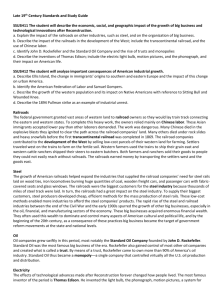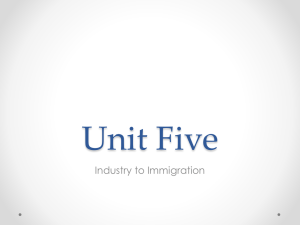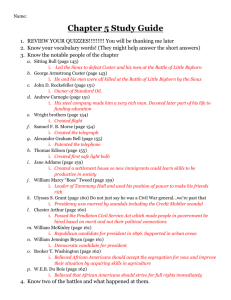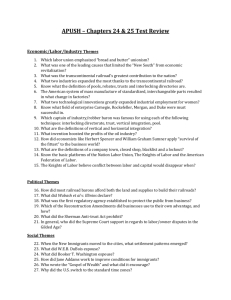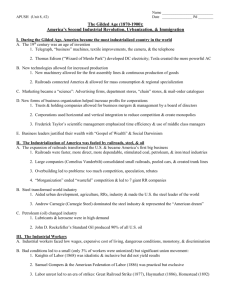Big Business and American Industrialization
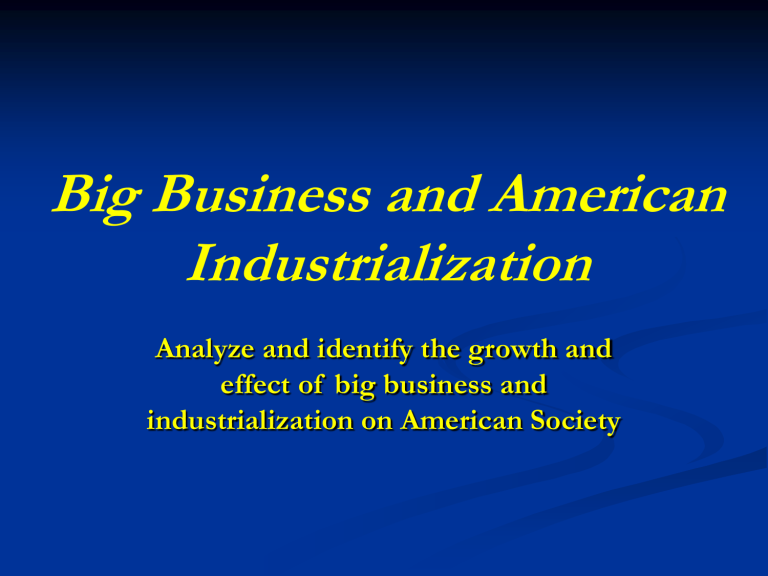
Big Business and American
Industrialization
Analyze and identify the growth and effect of big business and industrialization on American Society
The Indian Wars 1870-1890
Causes-
Culture: Native Americans believe that nobody owns the land;
Europeans see the land as natural and go west to claim it.
Gold Rush of 1849 and 1858Settlers move west to claim land and find their fortune. Thousands pour into Native American lands.
RailroadsFor the first time thousands can travel from the
Atlantic to Pacific Coast. Thousands move west
Treaty of Fort LaramieThe U.S. tried to contain Native
Americans in defined areas with land
1. Broken treatiesThe U.S. was constantly breaking these treaties and allowing settlers into Indian territory so most Native Americans refused to follow these treaties.
Reasons for Native American Resistance
Land AvailableNative Americans resisted the approach of American settlers because there was no place to go anymore.
1. Great PlainsArea stretching from Kansas to Wyoming was originally a reservation for Native Americans.
2. Buffalothe main food supply of Plains Indians who use the newly introduced horse to hunt them down; gave up farming.
3. ReservationsUsually the poorest and worse land in an area, which caused many to struggle to survive and rebel against the U.S.
Native American view of landnot their’s to own directly opposite Europeans.
1. Europeans view of landif its not settled or farmed then it’s open for them to claim.
Homestead Act of 1862grants 160 acres to each family and leads to a mass migration to the West of almost one million settlers.
Key Battles of the Indian Wars
Sand CreekU.S. Army troops ambush and massacre 150 Cheyenne and Arapaho
1. During the Indian Wars the U.S. Army routinely killed defenseless people, which resulted in similar revenge tactics by Native Americans.
2. “The only good Indian is a dead Indian”
-
Bozeman TrailSioux Nation upset over settlers constantly passing through their land ambush and kill soldiers.
-
Red River Warsecond uprising by the Sioux Nation caused by the discovery of gold in the Black Hill Mountains of South Dakota
(sacred site to the Sioux).
Key Battles cont’d…
Battle of Little Big HornLast major victory of the Indian Wars led by Sitting Bull and Crazy Horse .
1. General George Custerhe wanted the glory of defeating the Sioux Nation and attacks a Sioux camp.
2. Massacre7 th Cavalry was killed by the Sioux Nation and scalped.
3 . 1881Sitting Bull surrenders to the U.S. Army rather than let his people starve in war.
Ghost Danceritual to regain lost lands spreads among Sioux on
Dakota reservation; Sitting Bull is killed in 1890 on the reservation.
Battle of Wounded Kneelast major battle and end of the Indian
Wars, 300 unarmed Sioux are massacred by the U.S. Army.
Populist Movement
Reason Behind itorganized to address the needs of farmers/poor/disenfranchised in America who are being bled dry by banks, railroads and big business.
Populism —movement of the people; Populist Party wants reforms
Economic Ideas: increase money supply, graduated income tax, federal loans
Political Ideas: Senate elected by popular vote; secret ballot; 8-hour day
Legacy of the Populist Movement-
1. Powerless can organize and have impact on American Society
2. Ideas become a part of American Society in the 20 th century
The Panic of 1893
Government’s gold supply depleted, leads to rush on banks
1. Businesses, banks collapse causing panic which leads to an economic depression.
2. Silver or Goldpeople argue for each one as the backing of paper money.
Bimetallism - Idea proposed in which both silver and gold are used to back currency
1. Gold standard: backing currency with gold only
2. Paper money considered worthless if cannot be exchanged for metal.
3. Silverites: bimetallism would create more money, stimulate economy.
4. Gold bugs: gold only would create more stable, if expensive currency
Cause of American Industrialization
1865-1900
Natural resourcesthe U.S. had all the essential raw materials- coal, iron, oil, copper, lead and timber
Labor SupplyBetween 1865-1900 hundreds of thousands of immigrants poured into the United States
TransportationBy the late 1800’s the U.S. had the largest most advanced network made it the largest market in the world.
CapitalMoney poured into the country to develop new industries and trade.
Cause of American Industrialization cont’d…
New TechnologiesBetween 1865-1900 an explosion of new ideas and technologies made life easier.
Government SupportThe U.S. supported big business with protective tariffs, little regulation, little taxes.
RailroadsU.S. government gave out huge land grants and loans to railroads.
EntrepreneursThe U.S. was filled with people who built vast industrial and commercial businesses out of scratch during this era.
Rise of Industries in America
Positives
More Jobs
Inventions made life more comfortable and easier
Growth of Cities
Philanthropy Developed
New Industrial
Services/Products
Higher Standard of Living
Negatives
Only a few got wealthy on the backs of the workers
Living and working conditions in cites were poor and unhealthy
Slums emerge in cities
Overcrowded cities
Rise in crime rates
No sewage systems
Low wages and long hours
High poverty rates
Impact of the Railroad on the growth of America
Railroadshad the biggest impact more than any other technological invention of the 19 th century.
Chinese Laborthousands are brought in to build the railroads in the West and
Great Plains.
1. Conditionsharsh, little protections, disease, high death toll.
Peoplesee the railroad as romantic, give them a chance to start their lives fresh.
Transcontinental RailroadThe first coast to coast railroad was built in 1869 and met in Promontory Point, Utah.
1. CompetitionThe Union Pacific Railroad company built track from East to West. While the Central Pacific built track East from California through the Rocky Mountains.
2. Additional LinesBy the end of the 1800’s five transcontinental lines were built connecting the East and West coasts of America.
Impact of Railroads on America
Positive Impacts
1. Settlementallowed for the settlement of the west and expansion of America
2 . Connectionsrailroads connect isolated towns, promote trade and interdependence.
3. Tradetowns begin selling huge supplies of their products nationally. Iron, Steel, coal, glass and timber companies grow to meet the demand of the railroad.
4. Time Zones24 different time zones established to regulate railroads, soon adopted by the world.
5. Businessdevelopment of the modern stockholder company and regulations.
Negative Impacts
1. PricesMonopolies develop after the panic of 1893, they set high rates and kept farmers in debt .
2. CorruptionRailroads sell the land they received from government land grants to businesses not settlers .
3. The Interstate Commerce
Act of 1886passed to control the practices of the railroads.
4. Cornelius Vanderbilt-
Robber-baron of the Railroad industry he wanted to crush competition and develop a monopoly.
5. George Pullmancreated the railcar industry and factory system that controlled all aspects of a workers life.
Steel Industry
Bessemer Processthis puts air into iron and creates steel. Which is much stronger and lighter than iron.
Andrew CarnegieA Scottish immigrant he would be among the famous business leaders of the late 1800’s to change American businesses. By 1900 he controls almost three-fifths of all steel.
1. TechnologyCarnegie used the latest tech to beat his rivals and corner the market in the sale of steel.
2. Vertical Integrationa company controls every stage of the industrial process; from raw materials to finished products.
3. Horizontal Integrationcontrol competing companies
4. PhilanthropyCarnegie was the first major businessman to donate large portions of his income to helping the poor and underprivileged. They become Robber-Barons.
New Ideas in Business
Social Darwinismpeople use the idea of Charles Darwin that only the strong survive and apply it to life and business.
1. Rich are rich because they are better than the poor who are lazy and pathetic.
Laissez-Faire Capitalismthe idea that the government should not regulate business practices but the law of supply and demand should control business.
Monopoliescompanies control everything from the beginning to the end of their businesses.
1. Competitioneliminate it by buying your competition out or selling too low and drive them out of business.
2. Priceskeep them high to make the most money possible.
3. Wageskeep them low to make the most money possible.
Standard Oil Company
John D. Rockefellerhe used new technologies and efficient practices to gain control of 90% of the oil industry.
1. Trusta mixture of companies put together by Rockefeller that are separate on paper but united under one board, it controlled every phase of Standard Oil. By controlling the supply, shipping, manufacturing and pricing Standard Oil became a huge monopoly.
2. Profitsby the time of his death Rockefeller was worth 900 million, made money by paying low wages and cutting prices to drive out competition.
Antitrust Movement-
1. Sherman Antitrust Act 1890trusts and monopolies are illegal if they interfere with free trade. No teeth until the
Progressive Era in the early 1900’s.
Technology Changes Everything
Thomas Edisonin Menlo
Park, New Jersey he establishes his research laboratory. This made inventions a team thing rather than a single person idea.
1. Incandescent light bulb
2. Phonograph
3. Motion Picture Camera
4. Motion Pictures
Other Key Inventions and
Inventors.
1. Typewriter
2. Cash register
3. Kodak Camera
4. Fountain Pen
5. Gillette Razors
6. AC current
7. Bell Phone
8. Elevator
Workers demand rights
Work Hoursmost work 12-16 hours a day 6 days a week; no vacation, no injury compensation, no sick leave.
1. Jobsrepetitive and mind numbing.
2. Wagesdetermined by supply and demand always more workers than needed so pay was very low.
3. Familieseveryone worked to support the family including children.
4. Womenworked in sweat shops, required little skill and paid almost nothing.
5. Childrenwere put to work in small places in factories, mines, newspapers and messengers
.
Labor Unions
Samuel Gompersfounds the American Federation of Labor (AFL) a craft union with people from all skilled trades.
1. SuccessUses collective bargaining to win: higher wages, shorter workday, improved working conditions.
2. Most unions ban Blacks, women and children.
Industrial Workers of the World (IWW)Organized by radical unionists, socialists; include African Americans
1. Socialismwhen the government controls business and property; equal distribution of wealth.
2. Dignityunskilled workers feel labor unions give them dignity and solidarity.
Industrial Warfare
To fight the organization of labor unions, Business owners struck back
1. Lockoutclosing the factory to break a labor movement before it starts
2. BlacklistsPro-union employees circulated and banned from jobs.
3. Strikebreakershired thugs who beat up workers on strike
4. Yellow-dog contractsworkers sign this when hired and agree to never join a union.
5. Government supportalmost always the national guard or army called out to break a strike if it turned violent.
Major Strikes
Railroad Strike of 1877railroad companies cut wages but a strike brakes out and spreads to over
500,000 workers in 11 states.
1. President Hayesuses the military to put it down and over
100 people die
Homestead Strike 1892a manager in a
Carnegie Steel Plant uses lockout, strikebreakers and blacklists to break a union after he cut the wages of workers by 20%.
1. Union steel workers don’t organize again until 1937.
Pullman Strikelays off 3,000 workers, cuts wages but keeps the rent at the same rate.
1. FiredPullman fires the head of the workers unions.
2. Federal troops brought in to break the strike.
3. Resultsalmost all workers fired and blacklisted by the Pullman company.
4. Union Leaderssee that conventional means can’t work and turn to more radical, violent ideas to gain Union rights
Immigration changes America
Between 1870-1920 20 million immigrants come to the United States
1. New Farm MachinesEuropean farm workers lose jobs to new technology
2. European citiesovercrowded and high unemployment
3. Religious PersecutionJews and others attacked in European countries.
4. Religious/Political Freedomimmigrants wanted to live in a “free” country.
5. Jobsplenty of jobs available in factories in U.S. cities.
6. Transportationcheap costs of one way trips to
U.S.
Old Immigrants vs. New Immigrants
Old Immigrantscome from Western Europe
(England, Germany,
Scandanavia) and speak
English and Protestant.
1. High level literacy and skills made it easier to accept them into American society.
New Immigrantscome from southern and eastern
Europe (Italian, Greek,
Russians, Polish) and are
Roman Catholic, Jewish and Greek Orthodox.
1. Most are unskilled, poor, illiterate and young men.
Immigration cont’d..
Ellis Islandchief U.S. immigration station, in
New York Harbor.
1. Immigrants given physical exam by doctor; seriously ill not admitted
2. Inspector checks documents to see if meets legal requirements
3. Between 1892–1924, about 17 million immigrants processed at Ellis
Island
Immigrant Neighborhoods
Cooperation leads to Survivalimmigrants move to areas of the country where there are a large number of similar immigrants.
1. Sharereligion, cultural values and language.
2. Melting PotU.S. develops the idea of abandoning old culture an blending into American culture; immigrants refuse leads to backlash.
Backlash to Immigration
Nativismpeople who favor native born Americans; believe Anglo-Saxons are superior to other immigrants.
1. Religionobjection over Jews and Catholics.
2. SupportLabor Unions, Racists and antireligious groups.
Chinese Exclusion Act 1882places a ban on all new immigrants from China
1897 Literacy Billonly literate could enter the U.S., vetoed by the President.
Urbanization
Urbanizationthe move from county to cities was caused by
Industrialization.
1. Immigrantsmainly settle in cities were jobs and neighborhoods located.
2. African-Americansimmigrate to North to find jobs escape discrimination. Over 1 million move North and
West to cities. JIM CROW LAWS
Problems in Cities
1. Waterno indoor water in 1860’s; developed but rare by the late 1800’s.
2. SanitationStreets are open garbage dumps, sewer lines develop in the early 1900’s.
3. Police and Firenot enough to provide any protection crime is rampant and fires can spread rapidly.
